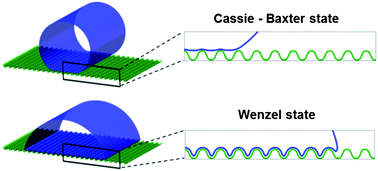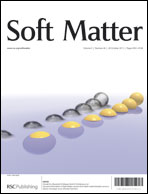Enabling efficient energy barrier computations of wetting transitions on geometrically patterned surfaces†
Abstract
Proper roughness design is important in realizing surfaces with fully tunable wetting properties. Engineering surface roughness boils down to an energy barrier optimization problem, in which the geometric features of roughness serve as the optimization parameters. Computations of energy barriers, separating admissible equilibrium wetting states on patterned surfaces, have been demonstrated utilizing fine-scale simulators (e.g., lattice-Boltzmann for mesoscale and molecular dynamics for microscale simulations), however with substantial computational requirements. Here, by solving an augmented Young–Laplace equation with a disjoining pressure term, we demonstrate accurate and efficient computations of equilibrium shapes of entire millimeter sized droplets on patterned surfaces. In particular, by adopting a natural parameterization of the Young–Laplace equation along the liquid/air and liquid/solid interfaces, the tedious implementation of the Young's contact angle boundary condition at multiple three phase contact lines is bypassed. We, thus, enable the computation of wetting transition energy barriers, separating the well-known Cassie–Baxter and Wenzel states, as well as intermediate states, but with negligible computational cost. We demonstrate the method's efficiency by computing the equilibrium of droplets on stripe-patterned surfaces, and compare the results with mesoscopic lattice Boltzmann simulations. Our computationally efficient continuum-level analysis can be readily applied to patterned surfaces with increased and unstructured geometric complexity, and straightforwardly coupled with shape optimizers towards the design of surfaces with desirable wetting behaviour.


 Please wait while we load your content...
Please wait while we load your content...